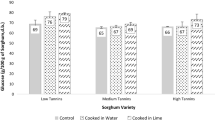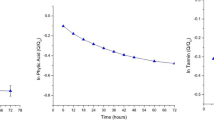Abstract
The effect of germination, cowpea fortification and fermentation on thechemical and amino acid composition of ogi-baba, a Nigerian fermented sorghum gruelwas investigated. The lowest protein value of 1.4% was obtained in the traditionally preparedsample, while samples prepared from germinated, fortified sorghum had 13%. The ash ranged from 0.9% to above 2%, while the fat was in the range of 1.2% to2.8%. Generally, fortification, in addition to germination, improved the chemicalcomposition of ogi-baba relative to the control sample. There was improvement in the amino acidprofile of all the ogi-baba samples compared to the unprocessed sorghum grains.Lysine, a limiting amino acid in sorghum, increased more than 50% in ogi-baba. However, samples prepared using germinated sorghum without the addition of cowpeas hada lower lysine content.
Similar content being viewed by others
References
Sanni AI, Onilude AA, Ibidapo OT (1999) Biochemical composition of infant weaning food fabricated from blends of cereals and soybean. Food Chem 65: 35–39.
Horn PJ, Schwartz HM (1961) Kaffir corn malting and brewing studies 9: Amino composition of kaffir corn grain and malt. J Food Sci 40: 65.
FAO (1970) Amino Acid Content of Foods and Biological Data on Proteins. FAO Nutrition Meat Report Series 24. Rome: Food and Nutrition Organisation of the United Nations.
Tsai CY, Dalby A, Jones RA (1975) Lysine and tryptophan increases during germination of maize seed. Cereal Chem 52: 356–360.
Asiedu M, Lied E, Nilsen R, Sandnes K (1993a) Effect of processing (sprouting and / or fermentation) on sorghum and maize II: Vitamins and amino acid composition. Biological evaluation of maize protein. Food Chem 48: 201–204.
Lorri W (1993) Nutritional and microbiological evaluation of fermented cereal weaning foods. PhD Thesis, Chalmers University of Technology, Gotenborg, Sweden.
Nche PF, Nout MJR, Rombouts FM (1994) The effect of cowpea supplementation the quality of kenkey, a traditional Ghanaian fermented maize. J Cereal Sci 19: 191–197.
Onigbinde AO, Akinyele IO (1983) Oligosaccharide content of 20 varieties of cowpea in Nigeria. J Food Sci 48: 1250–1254.
Guptill KS, Barey SA, Oni GA, Brown KH (1993) Evaluation of a face-to-face weaning food intervention in Kwara State, Nigeria: Knowledge, trial and adoption of a home prepared weaning food. Social Sci Med 36: 665–672.
Nti CA, Plahar WA (1995) Chemical and biological characteristics of a West African weaning food supplemented with cowpea (Vigna unguiculata). Plant Food Hum Nutr 48: 45–54.
Crook WM, Simpson WE (1971) Determination of ammonium in Kjedahl digests of crops by an automated procedure. J Sci Food Agric 22: 9–10.
Mortensen AB, Wallin H (1989) Gravimetric determination of ash in foods: NMKL Collaborative Study. J Assoc Anal Off Chem 72: 481–483.
AOAC (1990) Official Methods of Analysis, 15th edn. Arlington, VA: Association of Official Analytical Chemists, pp 725.
Losnegard N, Boe B, Larsen T (1979) Under sokelse at ekstrasjonsmidler for bestemmelse at fett. Nr. 1179. Fisk dir. Bergen, Norway.
Millipore (1987) Liquid chromatographic analysis of amino acids in feed and foods using a modification of the Pico-Tag method. Milford, MA: Millipore Corp.
Akinrele IA, Bassir O (1967) The nutritive value of ogi. J Trop Med Hyg 70: 279–280.
Asiedu M, Nilsen R, Lie O, Lied E (1993b) Effect of processing (sprouting and fermentation) on sorghum and maize 1: Proximate composition, minerals and fatty acids. Food Chem 46: 351–353.
Wang DY, Fields ML (1978) Germination of corn and sorghum in the home to improve nutritive value. J Food Sci 43: 113–115.
Hamad AM, Fields ML (1979) Evaluation of protein quality and available lysine of germinated and fermented cereals. J Food Sci 44: 456–459.
Mosha AC, Svanberg R (1983) Preparation of weaning foods with high nutrient density using flour of germinated cereals. Food Nutr Bull 5: 10–14.
Isai CY, Dalby A, Jones RA (1975) Lysine and tryptophan increases germination of maize seed. Cereal Chem 52:356–360.
Dalby A, Tsai CY (1976) Lysine and tryptophan increases during germination of cereal grains. Cereal Chem 53: 222–226.
Wu YV, Wall, JS (1980) Lysine content of protein increased by germination of normal and high lysine sorghum. J Agric Food Chem 28: 445–458.
Author information
Authors and Affiliations
Rights and permissions
About this article
Cite this article
Sanni, A., Asiedu, M. & Ayernor, G. Influence of processing conditions on the nutritive value of Ogi-baba, a Nigerian fermented sorghum gruel. Plant Foods Hum Nutr 56, 217–223 (2001). https://doi.org/10.1023/A:1011131929588
Issue Date:
DOI: https://doi.org/10.1023/A:1011131929588




